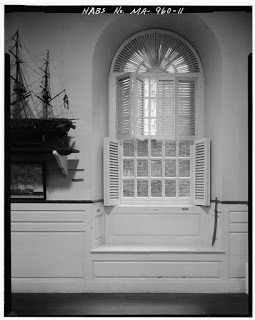Although foreign enemies never defeated USS Constitution, neglect nearly conquered her. Most shipbuilders expected their creations to last 20 years, at most. Constitution has been with us for 215. “Old Ironsides’” reputation secured her an extended life, but many times in her long career, she nearly met with an ignominious end. A similar fate nearly befell a miniature Constitution on loan to the museum.
This model of the real thing has languished in storage since 1978. Before that it was on display at the Old South Meeting House in Boston since 1903.
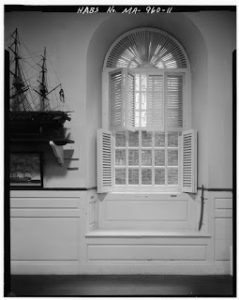

The loan records remind us that the model was commissioned by General Charles Greely Loring (1828-1902), a Civil War hero who later served as the first executive officer of the Boston Museum of Fine Arts for 26 years until his death in 1902. He asked a Constitution sailor to build him a model of the famous ship, and displayed it in his house in Pride’s Crossing (Essex, MA). Around 1878 a retired tar, a resident of Boston’s Old Sailors Home, rigged or possibly re-rigged the model. After Loring’s death, his wife contacted the Old South Meeting House and asked to put it on display there, where it remained until 1978.
Museums were different places in those days. Initially placed on a table, visitors got a bit too close and personal. In fact Loring’s son (also named Charles) wrote a letter in 1913 to the Old South Church Historical Society decrying the model’s condition: “I have noticed that the model of the Constitution which was loaned to you by my family is on a low stand without any protection from souvenir hunters or children, and that some of the details, such as boats and rigging, are missing.”
In response, the museum’s curator wrote, “I am sorry that you have found it in bad condition. We have to choose between convenient exhibition accompanied by small pilfering and somewhat expensive protection by glass or otherwise, and both methods have their disadvantages.” (Museologists everywhere take note!)
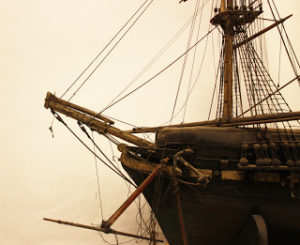

The museum subsequently placed the model on a small table made of timbers from the Old South Meeting House in a “colonial” style. This satisfied both parties but did not prevent the model from being pulled off its perch by a child in 1914. The damage was fully repaired, but that was the last anyone heard about it for more than half a century.
In 1976 the Old South Meeting House changed its mission and reduced the number of artifacts on display. The Loring model found a home at the new USS Constitution Museum, opened just a few years earlier at the Charlestown Navy Yard. The transfer took place at noon on April 25, 1978, and it was received by an enthusiastic curator Mr. Robert Badmington.
A report made shortly after detailed the model’s poor condition: “Examination reveals that the hull, rudder and spars are intact, except for the bowsprit, the forward end of which had been damaged prior to the move. Some of the standing and running rigging have deteriorated over the years. About one-half of the cannon have disappeared (probably removed by souvenir seekers). The model was displayed in the open air without benefit of cover. Naturally a layer of dust and grime has accumulated.”
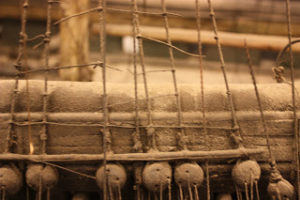

Although he had plans to restore the model, Mr. Badmington never got around to it. In 1992 the USS Constitution Museum asked the Loring family to donate the model to the Museum so it could be cleaned and repaired by members of the USS Constitution Model Shipwright Guild. Nothing came of this request and in 2003 the Museum again contacted the Loring family- it was time for the model to return to them: “Since it arrived here in 1978, the model has been deemed too fragile and in too much disrepair to be displayed. (…) Given its condition and its size (approximately six feet long and nearly five feet high), the USS Constitution Museum has deemed it too expensive to continue to store.” Fortuitously, there was no response and the Museum kept the model in storage.
In 2008, the Museum renewed contact with a Loring family representative who came and viewed the model in person in the summer of 2012. This visit renewed the Museum’s interest in the model and resulted in the final donation of the model to the USS Constitution Museum in December 2012. Rob Napier, a professional model restorer and builder, cleaned and restored the model with the assistance of members of the USS Constitution Model Shipwright Guild.
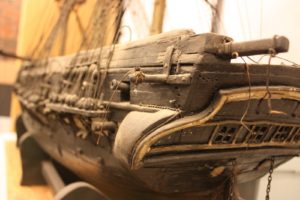

On February 5, 2013 the Charles Greely Loring model of USS Constitution will finally came out of storage. It joined sixty five other models in the the USS Constitution Museum’s Figgie Theater and was cleaned by modelers using Q-tips and a “mild enzymatic solution” to wipe off over 100 years of grime and dust. To read more about how the modelers cleaned the model, read our series of blog posts about their process. Next time you visit the USS Constitution Museum, be sure to stop by the modelers’ workshop on the first floor to see what the Model Shipwright Guild is up to now.
The Author(s)
Matthew Brenckle
Research Historian, USS Constitution Museum
Matthew Brenckle was the Research Historian at the USS Constitution Museum from 2006 to 2016.
